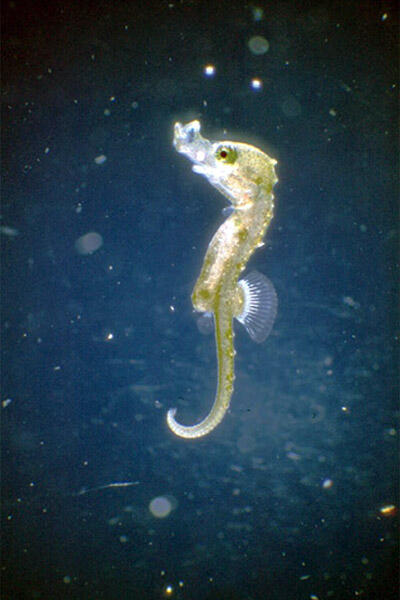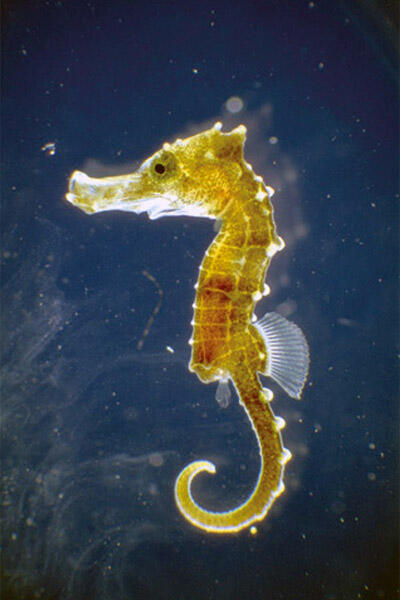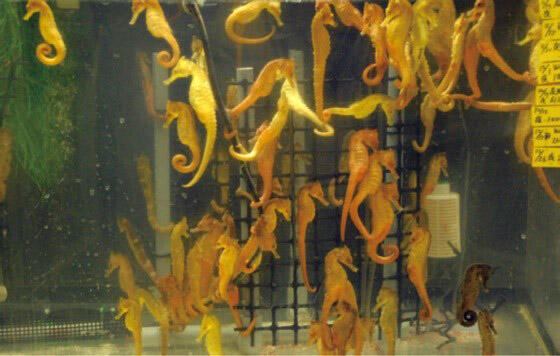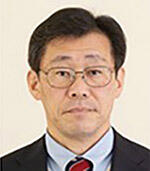"Sea horse (海馬)" is the generic name for all seahorses in the genus Hippocampus in China. Since ancient times, Chinese people have used seahorses in Chinese medicine for their revitalizing qualities. Preferred species include H. kelloggii, H. kuda, H. mohnikei and H. trimaculatus. They are sold in a dried state.
The major market of seahorses is China, but they are not creatures that inhabit a large area in the natural world, or rather they are a relatively rare species. For this reason, and to limit international transactions of seahorses, all species of seahorses in the genus Hippocampus are listed under Appendix II of the Convention on International Trade in Endangered Species of Wild Fauna and Flora (CITES).
Species listed under Appendix II may be traded internationally if permission is issued based on the exporting country meeting certain criteria. However, Japan has entered a reservation regarding seahorses. Against this backdrop, developing countries of the subtropical and tropical regions even today continue to catch and trade a large volume of seahorses for commercial profit.
The supply of wild-caught seahorses is unable to meet this demand, so aquaculture is desirable. If raising seahorses in marine farms can cover demands, it will be possible to supply the market, while contributing to wildlife conservation.
■ Origins of the research on seahorse aquaculture
In the context of these circumstances, the idea to conduct seahorse aquaculture was discussed in the Suruga Bay Regional New Business Incubation Project run by the Incubate & Promote New industry Organization (Shizuoka City, Shizuoka Prefecture), which was established by the members of the Shizuoka Chamber of Commerce & Industry, and the decision to conduct research and development on the idea was made.
The School of Marine Science and Technology at Tokai University has been conducting research on the culture of a range of aquatic species including bluefin tuna, thread-sail filefish, bigfin reef squid and the common octopus, making use of underground seawater taken from Miho Peninsula, Shizuoka, which retains the same temperature year-round and is anaerobic, therefore free of common bacteria. Based on these situations, this project also engaged in aquaculture research. In particular, Tokai University runs the Marine Science Museum and is knowledgeable in the exhibition of seahorse in an aquarium environment. Thus, the university had an advantage of easily obtainable information on seahorses, and its display and exhibition expertise would make it easy to obtain data on species often found in aquaria.
■ Biology of the seahorse
Seahorses have a most unusual shape, but their biology is also unique. Some fish, such as tuna and sardines, spawn a large number of small, floating eggs and disperse them over a wide area in the ocean, so that some of them will survive even if many eggs and juvenile fish end up being eaten by other species or dying due to being unable to feed themselves. This is a so-called risk dispersion model. Other breeding techniques to include scattering eggs across the seabed or depositing them on seaweed and rocks. Some species protect their eggs until they hatch. Some do not just stay next to their eggs to guard them, but they actually keep their eggs in their mouth. Seahorses are one such species that protect their own eggs.
Male seahorses have a brood pouch in their stomach area, into which female seahorses deposit eggs. The male releases sperm into the pouch to fertilize these eggs. Even after the eggs have hatched, the new-borns do not leave the pouch immediately and stay in the brood pouch until they finish absorbing the egg yolk, the nutrition they receive from their parents. In the case of the H. kuda, the offspring leave the pouch after 2-3 weeks. Once they have finished their yolk, the father bends and stretches his body to eject them from his pouch. Due to this process, it is said that male seahorses give birth.
The juveniles of H. kuda measure about 5 mm, yet they already have the same shape as their parents (Photo 1). Nevertheless, the juvenile seahorses do not have hard bones developed at this stage, which means they are unable to use their tails to grab seaweed like their parents. In the daytime, H. kuda usually crawl along on the seafloor, but at night, they grab onto an object and rest. However, despite having the same appearance as their parents, young H. kuda are not able to grab on to anything, so they float like plankton. Occasionally, young seahorses get mixed up with baby anchovies and sardines. They get caught along with whitebait because juvenile seahorses do not have good swimming abilities and are unable to grab on to anything, so they drift along in the sea like plankton. Interestingly, juvenile seahorses have a tendency to gather near light at night, due to their strong phototaxis, or ability to be guided by light. It is likely a behaviour enabling them to efficiently catch small plankton that swarm to light. This plankton phase ends after 2-4 weeks (Photo 2). After this, the young seahorses gravitate to the seabed where, like their parents, they swim as though they were crawling on the seabed during the day, while grabbing on to an object at night to rest.


■ Rearing seahorses
Seahorses prey on small crustaceans, so at aquaria and similar facilities, they are fed on live mysidacea. On such a diet, they spawn regularly and release their offspring. Nevertheless, the survival rate of their offspring once released from the father's brood pouch is extremely low. At best, a seahorse gives birth to nearly 1,000 juveniles at a time. However, only around 20 seahorses can survive until the time they are displayed. This is sufficient for the purpose of display and appreciation, but it is too inefficient if they are bred to supply the Chinese medicine market. Therefore, as an initial goal, it was decided to aim for a survival rate of 60% for H. kuda offspring up to the stage of seabed-settling, based on the consistent rate of over 60% achieved in the breeding of species such as red sea bream and flounder, where the breeding techniques are quite mature.
At the outset of the seahorse rearing project, the team followed the advice of reference papers and other information in terms of treatment of young seahorses and feeding methods, but none of these led to successful mass production. Amid such struggles, they turned the focus to the swimming ability of the seahorses. For normal fish, the caudal fin serves as the most propulsive force. Fish like tuna fold the dorsal, pectoral and pelvic fins, etc., into the indentation of the body to lessen resistance and maximize propulsion from the caudal fin to swim fast. However, seahorse tail is atrophied and curled up, so they swim slowly by fluttering dorsal and pectoral fins. As mentioned above, particularly for about the first four weeks after birth, the swimming ability of a juvenile seahorse is extremely limited due to its lack of hard bones. Many species of fish live like plankton after hatching when their appearance does not resemble their parents. During that period, many fail to find enough food and starve to death. This is called mortality at the early life stage. Baby seahorses were believed to be able to swim, because they look like their parents when they are born. However, baby seahorses have extremely poor swimming ability compared to other fish species. Furthermore, while the juveniles of most fish species are able to bend their bodies into an S shape and snap straight so they can immediately move a certain distance to catch and feed themselves. Seahorses are unable to do this and are poor swimmers. A seahorse feeds by opening its lower jaw and expanding its mouth to allow water in front of it into its mouth, swallowing the zooplankton contained in it. This is called suction feeding, which is a very inefficient way of consuming food. The team has noticed that the way seahorses feed raises the possibility that they were not fed sufficiently.
For this reason, the team decided to significantly increased the density of Brachionus plicatilis (marine rotifer) boosted with n-3 highly unsaturated fatty acids, which is a food source and vital nutrient for H. kuda, compared to normal fish feeding. Typically, a seahorse eats one 300 micron-long marine rotifer per feeding session, but if this fails, it does not get any nutrients. Then, the density of marine rotifer was raised to 50-200 per cc. This figure is equivalent to the density at which marine rotifers are cultivated. Under normal circumstances, rearing living creatures at such density is impossible. Yet, as a result, the juvenile H. kuda seahorses started to eat so much that their stomachs swelled to the extent that had never been seen before. This enabled the team to raise the survival rate to seabed-settling.
Nevertheless, a range of issues have prevented stable production using this method, such as dramatic deterioration of water quality and in some cases, the proliferation of certain bacteria. Recently, however, a survival rate of over 95% has been achieved in some cases, indicating that the issues preventing the stable production are moving forward to reach solutions (Photo 3).

■ Future prospects
As has been seen so far, the problems involved in raising juvenile seahorses are well on the way to being resolved, however, problems remain regarding parental spawning. Feeding seahorses live Neomysis awatschensis (opossum shrimp) ensures large volume production of high-quality eggs, but the volume of eggs reduces greatly when they are given this feed as a frozen product. The volume reduces gradually to under 100 eggs. The feed given to artificially raised parents is not limited to frozen opossum shrimp, as they often eat krill and whitebait too. Although a vitamin preparation is added to the frozen feed before it is given to seahorses, it does not stop the reduction in egg count. A geographic location where live opossum shrimps could be consistently supplied would solve almost all of these problems.
By further resolving these issues in the future, complete aquaculture using fully enclosed circular filtration can be conducted in any place, enabling the demand for seahorses to be fulfilled without having to catch them in the ocean.

Tokai University School of Marine Science and Technology




